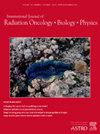Comparing Radiation and Systemic Therapy Patients’ Longitudinal Satisfaction of a Cloud-Based Bidirectional App Used for Real-Time Communication of Patient-Reported Cancer Treatment Symptoms
IF 6.4
1区 医学
Q1 ONCOLOGY
International Journal of Radiation Oncology Biology Physics
Pub Date : 2024-10-01
DOI:10.1016/j.ijrobp.2024.07.027
引用次数: 0
Abstract
Purpose/Objective(s)
A cloud-based bidirectional app (ePRO) communicating real-time patient-reported cancer treatment symptom(s) and clinical care team (CCT) recommendation(s) can lessen treatment burden. However, symptoms manifest differently for radiation therapy (RT) and systemic therapies (ST) and CCTs require one solution to be effective for both groups across time. This study tests whether there is a longitudinal difference in app satisfaction scores, a proxy for overall app utility, between these two groups.
Materials/Methods
The study focuses on a subgroup of Noona users who have reported app satisfaction 2 or more times (n = 7,202). They, and all other patients, have access to three primary features. In the first, the CCT uses the software to administer CTCAE-derived items at a cadence based on the treatment regimen (e.g., weekly for radiation therapy). Patients can also complete it ad hoc. When patients report moderate or severe symptoms, they receive programmed recommendations and the software triages patient in order of urgency on a clinic-facing dashboard so that a team member can efficiently follow-up with additional questions or instructions. The app also includes a diary patients can use to record any personal information, as well as a secure communication feature which facilitates exchange of additional medical and non-medical information with the CCT. Data used for this study include passively collected, anonymized information and a patient satisfaction item that randomly asked those with active accounts > 30 days, “How likely are you to recommend (software name) to another patient” using an 11-point scale. Data are reported descriptively and analyzed using a linear mixed model with patient as a random effect and repeated measurements with an autoregressive covariance structure.
Results
Most patients were from the United States (n = 4,941; 12 sites), followed by Canada (n = 1,700; 4 sites) and Europe (n = 561; sites = 5). The mean age was 61.7 (SD = 11.8). Most were English speakers (n = 6,794; 94.3%), used a smartphone (n = 5,480; 76.1%), and were, based on the module they were assigned, receiving systemic therapy (n = 6,468; 89.8%). The mean number of times a patient reported app satisfaction was 3.1 (SD = 1.6; range = 2-13). The mean of the patients’ first satisfaction score was 8.5 (SD = 2.5) and 5,704 (79.2%) rated the app ≥ 8. The satisfaction level was generally maintained across subsequent ratings. The regression model found that satisfaction levels for patients receiving radiation did not significantly differ (B = 0.205; P = 0.835) from those receiving systemic therapy after adjusting for the other 5 variables indicating that, over time, patients regardless of the treatment reported similar app satisfaction scores.
Conclusion
A single solution for cancer patients was highly rated by patients regardless of treatment and suggests that ePRO use helps address a critical, unmet need throughout their cancer journey.
比较放射治疗和系统治疗患者对用于实时交流患者反映的癌症治疗症状的云端双向应用程序的纵向满意度
目的/目标:基于云的双向应用程序(ePRO)可将患者报告的癌症治疗症状与临床护理团队(CCT)的建议实时传达,从而减轻治疗负担。然而,放射治疗(RT)和全身治疗(ST)的症状表现不同,因此临床治疗小组需要一种解决方案来同时对两组患者有效。本研究测试了这两组患者的应用程序满意度得分(应用程序整体效用的代表)是否存在纵向差异。材料/方法本研究的重点是已报告应用程序满意度 2 次或 2 次以上的 Noona 用户子群(n = 7,202 人)。他们和所有其他患者都可以使用三个主要功能。首先,CCT 使用软件根据治疗方案(如放疗每周一次)的节奏来管理 CTCAE 派生项目。患者也可以临时填写。当患者报告中度或重度症状时,他们会收到程序化建议,软件会在面向诊所的仪表板上按紧急程度对患者进行分流,以便团队成员有效地跟进其他问题或指导。该应用程序还包括一个日记,患者可以用来记录任何个人信息,以及一个安全通信功能,便于与 CCT 交换更多医疗和非医疗信息。本研究使用的数据包括被动收集的匿名信息和一个患者满意度项目,该项目随机询问那些拥有有效账户 30 天的患者:"您有多大可能向其他患者推荐(软件名称)",采用 11 分制。结果大多数患者来自美国(n = 4,941; 12 个站点),其次是加拿大(n = 1,700; 4 个站点)和欧洲(n = 561; 5 个站点)。平均年龄为 61.7 岁(SD = 11.8)。大多数人说英语(n = 6,794; 94.3%),使用智能手机(n = 5,480; 76.1%),根据他们被分配的模块,正在接受系统治疗(n = 6,468; 89.8%)。患者报告应用程序满意度的平均次数为 3.1 次(SD = 1.6;范围 = 2-13)。患者首次满意度评分的平均值为 8.5(标准差 = 2.5),5704 人(79.2%)对应用程序的评分≥ 8 分。在随后的评分中,满意度基本保持不变。回归模型发现,在对其他 5 个变量进行调整后,接受放射治疗的患者的满意度与接受系统治疗的患者的满意度没有显著差异(B = 0.205; P = 0.835),这表明随着时间的推移,无论接受何种治疗,患者都会报告类似的应用程序满意度评分。
本文章由计算机程序翻译,如有差异,请以英文原文为准。
求助全文
约1分钟内获得全文
求助全文
来源期刊
CiteScore
11.00
自引率
7.10%
发文量
2538
审稿时长
6.6 weeks
期刊介绍:
International Journal of Radiation Oncology • Biology • Physics (IJROBP), known in the field as the Red Journal, publishes original laboratory and clinical investigations related to radiation oncology, radiation biology, medical physics, and both education and health policy as it relates to the field.
This journal has a particular interest in original contributions of the following types: prospective clinical trials, outcomes research, and large database interrogation. In addition, it seeks reports of high-impact innovations in single or combined modality treatment, tumor sensitization, normal tissue protection (including both precision avoidance and pharmacologic means), brachytherapy, particle irradiation, and cancer imaging. Technical advances related to dosimetry and conformal radiation treatment planning are of interest, as are basic science studies investigating tumor physiology and the molecular biology underlying cancer and normal tissue radiation response.

 求助内容:
求助内容: 应助结果提醒方式:
应助结果提醒方式:


